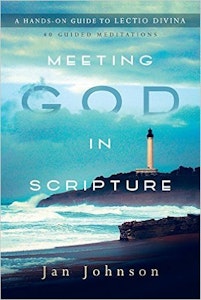 Excerpt from Meeting God in Scripture
Excerpt from Meeting God in Scripture
To apply Scripture is to ask oneself, how does my behavior or thinking compare with the principles of this passage? Although this is an excellent question, we often answer it by naming a few of our faults that people have pointed out to us! If we’re more open to the Spirit, God may bring to mind a new idea or positive reassurance that fits exactly.
Scripture meditation resembles application in its process of asking, how does this passage intersect with my life? In Scripture meditation, however, we do not have to come up with a way that the Scripture applies to us. Instead, we wait to get a sense of what God may be saying to us through the Scripture. In other words, we do not initiate this; God does. Nor is it always corrective; often it’s something we simply need to be assured of, such as I am loved!
Answers may not come immediately, but the lectio divina process opens us up to an ongoing conversation with God all day in which answers may come from unexpected sources. So application is analysis, not reflection. Discerning an application is a helpful left-brain activity where you connect the dots between the principle of the passage and your life. Meditation is right-brained and intuitive. We let go and listen for what God thinks we need to know.
The effect of meditation is different too. Instead of feeling pressured to change our behavior, we let the Spirit invite us into a next step. While application may often feel coerced (The passage says X, so you should do X), meditation is an invitation (See how Jesus did X? Why don’t you try X?)
Because transformation is as much caught as taught, meditation allows you to “catch” things from the Spirit through the words of Scripture. Meditation then results in a change of character that is unforced and at times seems unplanned. Instead, it is organic.
Scripture meditation goes much deeper than simple application. It opens us up to being completely undone by the Spirit and remade in the presence of the Word of God.
Excerpted from Meeting God in Scripture by Jan Johnson (InterVarsity Press, 2016). You may purchase this title from the publisher by clicking HERE.


